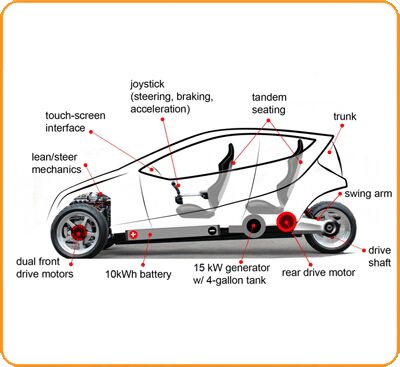#atvm
Elio Motors Applies for $185 Million Dept of Energy ATVM Loan
The most recent news out of the Elio Motors will provide grist for the rhetorical mills of both skeptics and enthusiasts of the startup car company. As we anticipated in our most recent post about Elio, the company has applied for a loan from the U.S. Department of Energy’s newly revived Advanced Technology Vehicles Manufacturing (ATVM) loan program. Though Congress had allocated $25 billion for the ATVM loans, less than half was disbursed before the program was put on hiatus in the wake of the failure of Fisker, which had been granted about half a billion dollars in loan guarantees. Elio Motors announced that it will be seeking a loand of $185 million to “accelerate the company’s plans to begin production” of their enclosed tandem reverse trike next year.
DOE Revives Loan Scheme For Auto Makers
After unwinding their Advanced Technology Vehicle Manufacturing loan program in 2011, the Department of Energy is bringing it back. According to The Detroit News, the focus of this round will be on suppliers, as well as lightweight vehicle technology.
U.S. Dept. of Energy to Resume ATVM Alternative Vehicle Loan Program
Though it has been criticized by those who oppose government financing of business, in part because of the failure of Fisker, one of the recipients of the U.S. Department of Energy’s Advanced Technology Vehicle Manufacturing loan program, the DoE has announced that it will resume marketing the ATVM to industry and possible applicants. About 60% of the $25 billion that Congress allocated to the program still remains. No loans have been made since 2011.
“With no sunset date and more than $15 billion in remaining authority, the program plans to conduct an active outreach campaign to educate industry associations and potential applicants about the substantial remaining funds available and the application process in general,” a Dept. of Energy spokeswoman said.
Has the Dept of Energy's Advanced Technology Vehicle Manufacturing Program Been a Failure? Not Really
Critics of the current administration have pointed to the impending bankruptcy of Fisker Automotive and the recent suspension of operations at taxi maker Vehicle Production Group as examples of why the government shouldn’t be picking winners and losers in it’s zeal to promote alternative energy. The DoE effort under which those two companies received financing is the Advanced Technology Vehicle Manufacturing Program, ATVM. Putting aside political ideologies, contrary to the image given by the apparent failure of Fisker and VPG, the ATVM program actually has a pretty decent track record when it comes to picking winners and losers.
Smyrna And The Solyndra Problem
Ever since the messy collapse of solar panel maker Solyndra just two years after it received over half a billion dollars in government loans, the political climate around all green energy loan programs has heated up considerably. As the White House opened an investigation of the Department of Energy’s entire loan portfolio, loan recipients and startup automakers Tesla and Fisker found themselves under attack. And why not? Fledging firms with unproven products in brutal, scale-driven industries are hardly safe bets, even in the best of times. And with the government drowning in deficits, who’s in a gambling mood?
What gets left out in the hue and cry is that Tesla and Fisker between them represent “only” about a billion dollars worth of DOE loans in a program that was supposed to be able to loan out $25b (the final tally could be closer to $18b). Dwarfing the half-billion-each investments in Fisker, Tesla, and Solyndra are projects that seem a lot less risky in contrast to the startups. Here, in Smyrna, TN, I got to see one of them being built.
Why The Government Should Have Stayed Away From Fisker And Tesla
The Detroit News reports that the White House has ordered a review of the Department of Energy’s various loan programs in the wake of the Solyndra scandal, noting
White House Chief of Staff William Daley ordered an independent analysis on the state of the Department of Energy’s loan portfolio — including loans to solar, nuclear and auto companies.
“The president is committed to investing in clean energy because he understands that the jobs developing and manufacturing these technologies will either be created here or in other countries,” Daley said.
One of those programs is the so-called “Advanced Technology Vehicle Manufacturing” loan program, which was nearly used to fund the Detroit bailout and has since come under fire from various quarters. Twice already the Government Accountability Office has questioned the ATVM loan program for its lax oversight, weak goals, lack of technical support, inconsistency in awarding loans and the undetermined impact of funded vehicles. And those internal issues could help explain why the Center For Public Integrity has accused the ATVM program of operating a patronage scheme, alleging that major Obama donor and Tesla board member Steve Westly personally benefitted from loans made to the company. And on the Fisker side of things, backer John Doerr of the VC firm KleinerPerkins is another major Obama donor, suggesting a pattern of politically-motivated loan awards to well-connected EV firms that carry high risks. With government intervention in the auto industry still a hot-button issue in the wake of the bailout, this scandal has huge implications for the legitimacy of America’s emerging “industrial policy.”
DOE "Green Car Retooling" Loan Program Under Republican Assault, Are Chrysler's Finances At Risk?
Reuters reports:
Republican leaders in the House of Representatives want to halve the balance of a U.S. government loan fund established to help the auto industry make more fuel efficient cars and trucks.
If plans to shift some $1.5 billion from the Energy Department advanced technology fund to disaster assistance are carried out, serious questions would be raised about Chrysler’s ability to fully capitalize on its bid for new financing.
That the DOE loan program is under attack comes as no surprise: it’s been savaged by both the GAO ( twice) and the Center for Public Integrity for a lack of clear goals, weak oversight, misappropriation, and political patronage (more on the patronage bit here). And with the Solyndra DOE loan scandal blossoming, it’s no surprise to see ATVM going under the axe (although Rep Steny Hoyer is leading the Democrat pushback). What’s worrying about this development, however, is that Fiat-Chrysler CEO Sergio Marchionne has said that the DOE loan was “a crucial part” of negotiations over its recent Wall Street bailout loan refinancing. When GM quit the program earlier this year, Marchionne also said that
I have neither the arrogance nor the cash to show any disdain toward the DOE process.
Chrysler also cites its ability to secure the DOE loans as a major risk factor in its latest 10-Q SEC filing. And with only about $10.2b in cash and equivalents on hand at the end of June, there’s a chance that this attack on the ATVM loan program could deal a body blow to Chrysler’s finances. Here’s hoping Sergio has kept the runt of the bailed-out automaker litter from dependence on this apparently corrupt, and politically vulnerable loan program.
Truth Versus Advertising: Sex Is Sexier Than The Environment Edition
With the environment taking an ever-larger place in automotive advertising, it’s interesting to note that Fisker’s latest brochure puts green in its place: behind sexy. Of course these sultry images [via BusinessInsider] aren’t free from environmental overtones, featuring taglines like “designed to get you hot, not the planet,” but it’s clear that Fisker is more heavily relying on the most traditional tool in the advertising playbook. Why? For one thing, even though Fisker is delivering Karmas, the EPA has not yet certified its efficiency rating… so we don’t even know how environmentally friendly it is yet. For another the Karma’s main rival, Tesla’s forthcoming Model S, is pure electric and therefore more appealing to wealthy environmentalists. Finally, unlike environmental messaging, sex doesn’t remind people that Fisker was the beneficiary of over half a billion dollars in government loans. Plus, sex is still, well, sexy. The more things change, the more they stay the same…
UAW Backs "Strong" Emissions Standards After All… For A Price
Last week I wondered aloud about where the UAW stands on fuel economy, inspired by the union’s apparent flip-flopping between supporting the companies that employ its workers and backing its environmental allies on the left with talk of its commitment to green jobs. And after expressing concern about proposed CAFE increases, it seems the UAW is flopping back towards the environmentalist side of the equation, joining the so-called “Blue-Green Coalition” of labor leaders and environmental groups in expressing its vague support for “strong” emissions standards in a letter to President Obama [ PDF]. But with CAFE negotiations coming down to within 5 MPG or so of a final “number” for the 2052 standard, the letter’s lack of commitment means it’s still not clear where the UAW comes down in the policy debate. So instead of highlighting the union’s commitment to the environment, the letter ends up serving as a window into the UAW’s cynical, yet self-deluding side.
DOE Loan Program Knocked For Lax Oversight, Risk-Related Costs
The Department of Energy’s Advanced Technology Vehicle Manufacturing (ATVM) loan program has come under fire from the Government Accountability Office before, and was the subject of a patronage investigation by the Center for Public Integrity and ABC News. And the bad news keeps piling up, with yet another nasty GAO report [ PDF] taking the program to task for running up higher-than-expected lending costs due to “industry risks” and for failing to provide required technical oversight.




















Recent Comments